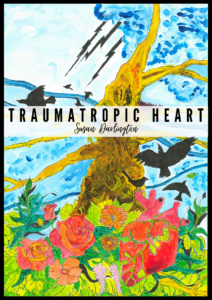
Source: Selcouth Station Press, (https://www.selcouthstation.com/product-page/traumatropic-heart-by-susan-darlington)
Traumatropic Heart is Susan Darlington’s second poetry chapbook, and follows Under the Devil’s Moon, published in 2015. While it continues the earlier publication’s air of the uncanny, the new work presents a greater sense of urgency, intensity and focus.
As an introductory paragraph from Paul Anthony Jones explains, ‘traumatropism’ is where an external, traumatic, event alters the development of a living organ, which becomes the central theme of the poems within this anthology. The collection’s title is pulling the reader in two directions. We are to anticipate trauma but also survival. As Jones says, the term ‘traumatropism’ “reminds us that nature is stronger and more resilient than we could ever imagine… it tells us that harsh setbacks need not end our progress.”
Accordingly, this chapbook presents dense and allusive poems that draw upon nature to throw light on female experience in a free verse whose musicality is appropriate for a writer who also works as a music journalist. Its folkloric nature is supplemented by a number of drawings by cover artist Mozibur Rahman Ullah, making the book an attractive package.
On repeated reading, a strong sense of unity emerged across the collection. One of the first examples of ‘traumatropism’ within the poetry book begins with an eponymous poem of a tree that survives a lightning strike and directly links to “heavy chambers / of my traumatropic heart”.
In the second poem, ‘Dry Velvet’, there is a further insight as a seed germinates but is “punished / for its pride.” We are in an entirely wild realm, presided over by eldritch forces. It is only within the third poem, ‘After the Storm Has Passed’, that the human world intervenes, and not in a positive way, with “the love I once felt for you / buffed glass smooth; clean of lies.” Through the layers of metaphor and inclusion of perhaps unfamiliar words such as: ‘traumatropic’, ‘vernix’, ‘chloroplasts’, Darlington creates an atmosphere of confidence and directness.
In the poem ‘Magpie Eggs (Two for Joy)’, the poem opens with:
“I’ve been collecting magpie eggs again, / their speckled mint shells gleaming dully / in the sunrise as I lift them from nests / and weigh them in my freckled hands…”
It’s a simple description of a routine activity – but it also has the slight taint of folkloric cruelty, augmented by the off-key jingle of ‘speckled’ / ‘freckled’. By the end of the poem, the nursery rhyme logic of counting magpies is invoked, as the narrator anticipates being “always surrounded by joy.”
Unsurprisingly, this is a vain hope, once we are on the way to discovering the crux of the collection. The next poem, ‘The Demolition’, brings a destructive note which is echoed in the wistfulness of a run of poems that reflect a breakdown in a relationship, building up to the sense of guilt that concludes ‘The Treehouse’.
It’s a little over halfway through, in ‘Hope’, that we explicitly encounter “the daughter that I never bore”. Though colourful, the imagery of this poem speaks of sterility and frustration – white sheets, menstrual blood, dying green shoots and hair silvering with age – and there is an uncontainable amount of longing in the “beat between when you ask / if I have children and I answer ‘no.’”
‘Stone Babies’ fixes this notion of childlessness as the central concern of the chapbook. The poem’s epigraph notes that, “A stone baby occurs when a pregnancy fails and the foetus calcifies while still in the mother’s body”. The starkness of this imagery of ‘stone’ adds to both the physical and psychological weight and trauma of carrying a baby whose “skin calcifies inside me.”
From this rock bottom, the traumatropic theme suggests there will be redemption and it does come – but it doesn’t come easily. ‘Silver Birch’ returns to the blasted tree theme as the ‘she’ of the poem is absorbed by nature. ‘She’ then begins to reassert herself in ‘Space2’, at the end of which her “teeth bared in a snarl / I make you look and finally see me.”
‘Scaffold’ and ‘The Last in a Long Line’ also engage with reconstruction before carnage occurs in the poem ‘The Dolls’ House’:
“it was anger that gave her the voice
to say no more; that made the dolls’ house crash
down around her. And as she rose from the debris
it was the first time she could truly breathe.”
For all the trauma within the collection, there is a sense of liberation, leading us into the charming coda of ‘Translate the Notes’ at the conclusion of the collection.
Traumatropic Heart is a powerful and emotionally-charged – yet also tightly controlled – work. I was slightly torn about whether I wanted a little more variety and some release from the intensity. However, in poems that stray from the central concern such as ‘The Trapeze Artists’, whose metaphor seemed a little too predictable – the loss of momentum convinced me that it is entirely right for Darlington to keep up the highly-charged and emotive poems that dominate the collection.
‘Traumatropic Heart’ can be purchased here from Selcouth Station Press.
Find out more about Susan Darlington via her Blog; Facebook; Twitter. You can follow the reviewer Mike Farren on Facebook; Twitter; Instagram.
Filed under: Written & Spoken Word
Tagged with: anthology, chapbook, leeds, poems, poetry, poetry collection, review, Susan Darlington, trauma, traumatropic



Comments